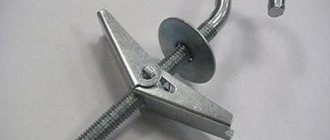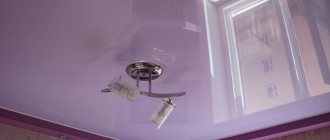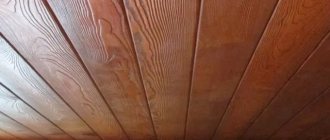What to do if there is a flood and water has accumulated in the stretch ceiling? Of course, we need to drain it from there - and preferably with minimal losses. How to do this yourself in order to save furniture, decoration, appliances and not aggravate the situation - we will look at this in this article.
Initially, you need to understand that a PVC ceiling is not just a beautiful decorative element, but a multifunctional element of the interior. If the neighbor above flooded the apartment, the film will hold all the water and make it possible to pump it out of the sagging ceiling.
If water has collected inside the fabric ceiling, it must be pumped out as soon as possible. The fabric is not designed for such loads and will not be able to retain moisture for a long time. But even such a canvas will give you time to remove the most valuable things from the room.
How much water can the ceiling hold?
Hypothetically, a stretch ceiling can withstand a load of up to 100 kg/m2. This means that the canvas in a 10 m2 room can withstand a ton of water. But you shouldn’t be rigidly attached to this figure.
How much water a suspended ceiling can withstand will depend on a number of additional factors:
- quality PVC film;
- installation level . Have all the installation rules been followed, have the installers saved on the number of screws, stiffeners, etc.;
- the presence of seams on the film (a soldered ceiling may not withstand a large volume of water and burst at the junction);
- ceiling area - the larger it is, the less load per square meter the film can withstand (the laws of physics have not been canceled);
- forms . Round - will withstand more weight than rectangular, and narrow and long - will protect better than square;
- tension level . According to the instructions, the area of the film should be 5–7% smaller than the size of the room (so that it does not sag, but is tightly stretched). But some manufacturers, in an attempt to save money, make the canvas 9-10% smaller. Such savings make themselves felt just in moments of critical situations. Excessive tension, combined with the weight of the water, leads to the film bursting or flying out of the fastenings.
When determining how many liters a particular ceiling can hold, it is better to proceed from the worst case scenario (both the installers and the manufacturer saved money, but the film turned out to be a fake) - in this case, the ceiling will withstand a load of 60-70 kg/m2.
If all the circumstances are most favorable (quality, size, shape), then the permissible load can be safely doubled.
Fabric ceilings have much worse performance:
- the fabrics used for stretching are not airtight. They are treated with special compounds that increase water resistance, but they do not provide 100% protection;
- Unlike film ceilings, fabric ceilings are not elastic. The weight of a large volume of water will simply tear the fabric out of its fastenings.
It is worth noting that fabric ceilings are ordered much less often than film ceilings and are installed in most cases in bedrooms and living rooms. While floods occur more often in kitchens and bathrooms.
�������� �������������� ��� ����� ���� � ��������� �������
���� �� �������� ������� ��������� ����, �� ��� �� ����� ����� ������� ������������. ����� ��������� � �����, ��������������� ���� �������. � ������� ������, � � ����� ������ ����������� ������ ����� ������ ������� ������ �� ����� ���� � �������.
����������������� ������� ������� � ����������� ������������� � �� ������ ������� �� �������� ����, ���������� ���������������� ���������, �� � ������ ��������� ������� ������� �����. ������ ������, ����� � �������� ������ �� ��������� ������� ������������ ����������. ��� ������, ��� ��������� ������� ����������� ������, � ��� �������� �����������������.
��� ����� ������� �� ������� ������������?
������� ��������� � ������ ��������� �������������. �������� ����, ������� ������� ����������� �� ����, ������� �������, ����������� �������. �������� ������� ����������, ��������, ����������� �������� ��������� ������� � ����������� ����.
Which materials withstand flooding better?
Of course, PVC film will withstand flooding better than fabric. If you manage to drain the water without damaging the stretch ceiling fabric, then after drying and reinstallation there will be no trace left of the flood. PVC film will return to its original appearance without losing color, shape or presentation.
The fabric fabric will not be able to withstand such a test. It will definitely have to be changed. If there was a lot of water, the fabric will tear out of the profile; the fabric cannot be reinstalled. A small flood will also completely ruin the fabric. After drying, a stain will remain on it, and the fabric itself may sag in the area of flooding.
How does the process of retaining liquid on the surface of the tension fabric take place?
Flowing down ceiling beams, walls and ceilings, the liquid falls on the inner surface of the tension fabric.
If the structure is fastened correctly and has sufficient strength, then the liquid accumulating on top will gradually stretch the film. The properties of polyvinyl chloride material allow it to withstand high mechanical tensile loads. A certain container is formed into which the liquid is collected, but it cannot in any way damage your furniture and things.
By purchasing a film ceiling from a trusted, well-known manufacturer, you can be sure that in an emergency it will help protect your property from damage and loss. When exposed to water, PVC film does not lose its color and ductility.
It remains just as attractive and does not require replacement after drying. There will be no streaks or smudges left on it. It is enough to wipe with a dry cloth - and the stretch ceiling will delight you with its pristine beauty.
How to understand that there is water there?
With fabric everything is simple - it will darken very quickly and begin to drip from it. With a large volume of water, the canvas will partially sag and then break out of the fastenings.
Nothing will leak from PVC film. The only possible leak is in the places where the curtain rods and lighting fixtures are attached, but this is rare. Due to the rigid fastening of the mounting rings to the floor slabs, the holes usually remain above the main sheet filled with water.
If there is a large volume of water, it will all gather in one place, and the film will sag like a bubble. The lower edge of the bubble can be 50–70 cm below the main ceiling level. Do not be afraid of this - after removing the moisture and drying, the canvas will return to its original appearance.
��� ����� ���� � ��������� ������� ��������������
������� ���� � ��������� ������� ���������� ����� ������ ���������� ���������� ��������.
��, � ���������, �� ������ ���������� ������� �������, ���� ���������� �� ���� � ��������� �����. ����� ��������� � �������� �������, � � ����������� ���. ��������� ��� ��� ���� �� ��������� ���� – ���� �� �������.
���������� ���� ������������� ��������. ������� ������� �����, ��� ����� ������� ������. � ��� ��, ���� ��������� ���� – �������, ����� �� �������� �������, ����� ������������.
������� �� ������� ���� ����� ����� ���������, � � ���������� ������������������ �������� ��������� �������������� ��������. ������ �����, ��� ���� ����� ���������������� ����� ���� � ������� ��� ��� ����� �������� �������� ������������ ��� ����, ����� ������� ��� «�������� ���». ���� ���� ����������� ������� ������� � �������� ������� �������� � ������ ������ �������� ������� � ����� ������ ��� �� �������.
��� ���� ������ � ����� � ������ ��������� ������� ��������� ������� � ��������� ����. �� ������� �����. ���� ����������� ������� ��� ������� ���� �������� �������, ������������ ��� ����� �� ���������.
���� � ��������� ������� ���� ����� �������, ��������� ��������� ��� ������������� ��������.
����������� ��� �����������.
��-������, – ��, �� ��� �� ������ ������ ��� �������� �������� ��������������� �����: ���� ��� ���������. ��-������, ������� ��� ����. ����� ���������� �� ������ ����� ��������� ���� ���������� ������.
������� ���� �������� �� ���������, ������� �������. ����� �����, ��� ����� ������������� �����. ����� ���� ������ �������, �� ����� �������� � ��� ����.
������� ����������. �������� ��������� ������, ���������� � ����������� ��������� �����.
���� �� ������ ��������� ��������� � ������� ���������. ������� ������������� ������ ������, ���������� ����������� ���, ����� ���� �� ����������� �� ����� �������. ��� ��������� ����� ���� ����������� ���������, �����, ���� �� �������, ��������� ����� ������� ����� � ����� �� ���������� – ��������, ���� ���� ����� �����.
����� ��������� ��� ������, ���� ����� �������, ���� ���������� ���� ��������� �������.
���������� ������� ������� �� ����������� �������� ��� ������� ���������. ���������� ����������� ��������, ���������� ���� ��� ���� ��� �����. ��������� ������� ���� � ����, ������ � ������� ������� �� �����.
����� �������� ���� ������� ����� ��������� ��������, ��������������� ������������ �����.
��� ������� ����, � ���� ������ ������� ��� �������, �� ��� ����������� ������� ����� �������� � ���������� ����. ����� �������� �����, ������� ��� ����������� � �������, ���� ��� ����. ��� ������� �������� ������� � ������������ ����� �������� � ��������.
���� ���� �� ��� ���������� �� ���� ��������������, ��� ����� ����� ����� ���������� � ����� � ������� ������������, ���� ��� ���������� ������� �� ��������� ��������, ������ � ��������� �������� �������� � ������� ������� �������������� ���.
������ ����� ������� ��������� ������� ����� ������� �� ����� �����������.
� ������, � ����� ���� � ������� �������������� ��� ������ ����� ��������. �� �� �������� ����� ������ �������� ����� �������� �� ������ �� ����� ���, �� � �� �������� �������. �� ������ ������� �������� ������������ ������� ��� ����� ������.
: beautyhalf.ru
Three ways to drain water
The only sure way is to call the manufacturer’s installers and entrust this work to them. Moreover, after removing the moisture yourself, you will still have to call them. Even if you managed to remove everything to the last drop on your own.
PVC film is airtight - therefore, the floor slabs will remain wet. Moisture will cause mold to appear, which can go down the walls and go beyond the stretch ceiling.
To avoid such a scenario, the canvas must be partially or completely dismantled after flooding. Dry everything thoroughly and reinstall.
Therefore, the remaining two methods can only be called a temporary solution to the problem.
Preliminary preparation
Before you start fixing the problem, you need to take care of your own safety. At the first signs of flooding, the room should be completely de-energized to avoid a short circuit or electric shock.
Then you should take care of the safety of household items. Take everything you can out of the room (primarily electrical appliances). It is better to cover the remaining items, furniture and floors with polyethylene.
After completing the initial tasks, it is worth identifying and eliminating the cause of the flooding . There are three options here:
- The upstairs neighbors flooded.
- Water supply pipes between floors burst.
- Failure of the heating system in the floor slab.
In the third case, there is no need to fix the problem yourself. Chemicals added to the heating system can have negative health effects during the leak repair process.
In the first two cases, you can cope on your own, having previously eliminated the cause of the flood (by contacting the housing office and closing the riser).
You need to prepare for the process of eliminating a flood so as not to make it worse than it was (tear the film or flood the entire room). There is no need to panic or rush. Water under the ceiling can remain for several hours without consequences, and in some cases for several days.
The most convenient way to fix the problem is with three people:
- the first one regulates and directs the jet;
- the second - continuously holds water containers;
- the third one pours the contents of the buckets into the sewer.
In extreme cases, two people can handle it, but in this case you will have to stock up on a large number of containers - after all, a suspended ceiling can contain hundreds of liters of liquid.
It will not be possible to eliminate a flood alone without proper preparation (either water will end up on the floor or the canvas will be damaged). If you couldn’t find helpers, it’s better not to waste your energy and nerves, but to wait for specialists.
If you managed to form a liquidation team, then in addition to buckets, it is advisable to acquire a stepladder and a hose - this will make the process much faster and more productive.
Removing water through technical openings (openings for lamps and cornices)
After completing the preparatory stage, you can begin draining. Getting water out of a stretch ceiling is quite simple. The main thing is to take your time so as not to damage the canvas.
Stages of work
- Carefully remove the lighting fixture closest to the leak (after first making sure that it is de-energized).
- If there is a rubber hose:
- insert it into the resulting hole so that one end of the hose reaches the empty container, and the other is immersed in water where it sags;
- create a vacuum in the hose (pump it out using a pump, or draw in some air from the hose, like from a cocktail straw), so that water begins to flow down it into the container;
- if the water masses are far from the end of the hose, they can be adjusted to the hole. If your height allows, use your hands; otherwise, use a soft mop. This should be done with smooth, wide movements without pressing hard on the canvas.
- If there is no hose:
- Place a container under the drainage hole. Spare buckets should be kept nearby so that filled ones can be quickly replaced with empty ones;
- carefully pull down the edges of the hole so that it is slightly below the main plane of the ceiling;
- Using a wide soft mop, gradually move the water to the pumping site.
- After the bubble at the flooding site disappears, we can assume that the bulk of the water has been drained, and the ceiling and repairs have been saved.
After this, you can safely wait for the repair team to dismantle, dry and reinstall the tension fabric.
Over the edge of the structure
If it is not possible to remove the chandelier, or the lamps and cornices are installed on the walls or in a plasterboard box rather than canvas, then the process of self-removal of water follows a different scenario.
Work progress
Initially, you need to find out by what method the canvas was secured. This information may be specified in the supply agreement, or you can check with your seller. If this information is not in the contract, as well as communication with the manufacturer, you can try to visually determine the installation method.
There are three main methods of attaching PVC film (for fabric canvas, the installation method is not important; the fabric cannot be reinstalled, so the ceiling will have to be changed in any case):
- Harpoon. The most common method of installing PVC ceilings. 90% of all products are installed using this method. To dismantle the edge of the ceiling, just remove the masking tape (to do this, simply pull it with your hand) and press the harpoon vertically upward, it will unfasten and come out of the groove. You need to press very carefully so as not to damage the canvas. A mild spatula with rounded edges is suitable for this purpose. If you don’t have a suitable tool at hand, you can use a plastic card or something similar in shape and properties.
- Wedge. With this installation method, dismantling the edge will be a little more difficult. You will have to pull out the masking insert, then carefully move the wedge to release part of the canvas.
- Clip-on. Dismantling the canvas with this installation is quite simple. Simply press gently on the edge of the film where it contacts the upper half of the clip. The clamp will loosen and the film can be pulled out of the latch. The main thing is to do everything smoothly and carefully, without sudden jerking movements.
Once the correct dismantling method has been established, the water can be removed. To do this, you will have to remove 50–100 cm of the canvas from the profile. If the dismantled part of the film is smaller, then there is a high probability that water from the suspended ceiling will flow onto the wall, ruining the wallpaper. Then after the flood you will have to carry out the repair again. If you clear a gap of more than a meter in length, then the combined weight of the film and water can tear out a much larger piece of canvas from the profile than planned. That is, spontaneous dismantling of the entire ceiling will occur.
Then you can proceed in exactly the same way as when working with a technological hole. Pump out the moisture by inserting the hose inside, or carefully release the water through the unfastened edge. The option with a hose is preferable, as there is less chance of flooding the wallpaper.
Features of using the lamp mounting ring
Some tension products are equipped with special valves that help remove liquid. When there is no such hole, you can use the mounting ring that is used to install the lighting fixture.
Before draining you need to prepare:
- hose;
- required number of containers;
- a stable table or stepladder.
First remove the lamp. One end of the hose is placed in the hole, and the other is directed into an empty container. When all the items are prepared, raise the water bubble and direct it to the area of the ceiling where the hole is prepared.
To perform the procedure, 2 people are needed. The first one will direct the flow and change containers, and the second one will clamp the hose if necessary.
Common mistakes when draining yourself
Hearing the sound of dripping water overhead (in a stretch ceiling, the impact of drops on the film membrane is quite loud and resembles a ringing drumbeat), most people begin to panic.
There's no need to rush. Having closed the riser and turned off the electricity, you need to sit down and think about how best to remove the water that has gotten inside.
A flooded ceiling can hold water for several days without consequences (even if a hundred liters have accumulated inside). Therefore, there is no need to panic and pierce a bubble of water in an attempt to urgently get rid of the flood.
By the way, making a hole in the film is a very bad idea. Even a tiny hole, under the influence of the gravity of the water, will spread out in a few seconds and turn into a huge meter-long hole through which a stream of water will rush like a waterfall onto the floor. As a result, the ceiling will be hopelessly damaged, and the furniture and repairs will be significantly damaged by the flood.
A natural question arises: why doesn’t the hole in the chandelier spread when water is drained through it? It's simple. During installation, special mounting rings made of thick plastic are glued around the perimeter of all technological holes, which keep the film from spreading.
The next common mistake concerns ceiling repairs after flooding. There is an opinion that by draining the water after a leak and waiting a couple of days (to dry), you can consider the issue closed and return to the usual rhythm of life. But it’s worth thinking about: will the concrete ceiling dry under the film? It is more likely that the moisture will remain there for a long time, it will be supplemented by mold, and the microclimate in the room will significantly worsen.
Some sources advise doing the drying yourself using an industrial or powerful household hair dryer - it’s not worth it. If this trick can still work with a fabric ceiling (but it will take a very long time to dry), in the case of PVC film these actions are absolutely useless.
Due to the tightness of the film, the maximum that can be achieved is to create steam in the gap between the floor slabs and the canvas. It will end up getting even worse. If previously one corner of the room was wet, then after the “steam bath” all the floor slabs in the room will become wet.
You should not count on the fact that excess moisture will escape along with steam through the soffit openings. To achieve this effect, you will have to continuously blow hot air onto the film for several days. During this period, the film will be damaged faster than the floor slabs will dry out.
Emergency measures when a bubble forms in a suspended ceiling
Before you drain the water from the suspended ceiling yourself, you need to protect the room as much as possible from inevitable contact with moisture. Even if it is possible to contact specialists to eliminate the problem, first of all you will have to take care of the following points:
- De-energize the room.
- Stop the flow of water: find out the cause of the flood, shut off the risers, notify the appropriate services.
- Take out valuables, equipment, carpets - anything that can be easily moved.
- Cover large furniture with waterproof material, film.
- Prepare as many containers as possible (during the draining process there will be no time to look for missing basins and buckets).
- Find 1-2 assistants (the work cannot be done alone).
You should not delay intervention, relying on the strength of the canvas: the longer the moisture remains in the under-ceiling space, the higher the risk of mold development.
Repair and elimination of the consequences of the flood
To avoid such a development of events, the film must be removed, at least partially, and everything must be dried thoroughly after flooding. You can do this in two ways:
- Temporarily leave the ceiling dismantled to dry naturally. This method is less expensive financially (you can dismantle the film yourself, paying only for re-installation), but inconvenient in terms of implementation. Depending on the time of year and the degree of flooding, drying can take from a couple of days to a couple of weeks. It will be very problematic to use the room all this time. A fabric that is unstable to mechanical damage will be laid out in it. If the family has small children or pets, most likely the PVC film will not survive such drying.
- Pay for a full range of services: dismantling, drying and re-installation. Money for these events can be demanded from the neighbors who caused the flood. This approach will reduce time costs to 1–2 days. In this case, responsibility for the performance of the work and the integrity of the canvas will lie with the company carrying out the work.
If there are doubts about the quality of drying, it is advisable to treat the floor slabs with antifungal compounds before reinstalling the stretch ceiling. This will prevent possible mold formation.
When reinstalled under the action of heat guns, the canvas will straighten out and take on its original appearance. But part of the canvas may be dirty (fingerprints, mop marks, etc.).
Cleaning after a flood is no different from regular ceiling cleaning. Using mild, non-abrasive products, all visible dirt can be easily removed from the film. Typically, manufacturers of household chemicals indicate on the label whether this product can be used on suspended ceilings.
Further actions
Having freed the ceiling covering from water, you need to thoroughly dry the material in order to return the structure to its original shape and prevent the formation of mold and mildew. Specialists will quickly and efficiently handle the task. Until a professional arrives, the hole through which you drained the water should be left open for ventilation.
If you want to save money, you will have to dry the material with a hair dryer. This long and painstaking work allows you to achieve excellent results - the ceiling will again become smooth and neat.
Can flooding be prevented?
The only way to prevent a flood is to eliminate all possible causes:
- change heating and water supply risers;
- negotiate with the upstairs neighbor to waterproof the floor.
But there are a number of nuances:
- new pipes may be defective, or the specialists involved in their installation may not be qualified enough;
- a neighbor may refuse to waterproof the floor. After all, this process will cause him a lot of inconvenience: high-quality waterproofing is a very expensive phenomenon, but why does a neighbor need extra expenses;
- it can only be carried out during a major overhaul, completely replacing the flooring, doors, etc.;
- if a flood is caused by someone living even higher up, then all the water will remain in the apartment of the neighbor above, and will not flow down, which is also not very good for him.
Therefore, it will be quite difficult to persuade a neighbor to carry out such work.
Theoretically, it is possible to waterproof the ceiling, but almost no one does this for two reasons:
- The height of the ceilings is reduced, and taking into account the additional loss of centimeters when installing the tension fabric, the total amount can be quite significant.
- The financial costs of high-quality waterproofing are higher than the costs of replacing a PVC ceiling, which makes this process unprofitable.
Due to the listed nuances, it is almost impossible to achieve one hundred percent protection from a flood, and even if possible, it is not practical in material terms.
How much does it cost to call specialists?
The cost of repair work depends on a number of factors:
- pricing policy in the region (in large cities and small towns the amount may differ significantly);
- area and complexity of the ceiling;
- installation method;
- a set of necessary services (installation, dismantling, drying).
The master will be able to name the exact amount only after visiting the site, but you need to focus on 30–50% of the original contract amount.
Don’t be afraid of such large numbers, because in the absence of a stretch ceiling, the cost of repairing and replacing furniture and equipment would be much higher.











